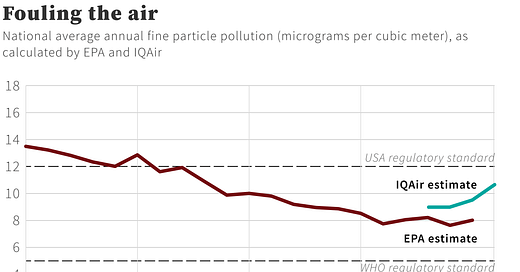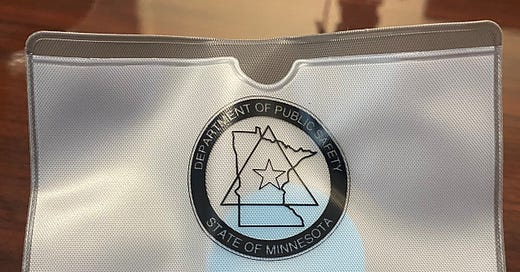American air got dirtier in 2021, according to the latest national estimate from Swiss technology firm IQAir. That increase isn’t just a reversion to pre-pandemic norms, either: data from several thousand air quality monitors from public and private sources show that national average fine particle pollution increased by about 15 percent between 2019 and 2021.
Those fine particles, known collectively as PM2.5, come primarily from vehicle exhaust, fuel burning, wildfires, and other sources. They’re of particular concern because once inhaled they get into the bloodstream and can even pass into the brain, causing a whole host of health and cognitive problems.
The body of evidence on the particles’ effects is fairly new but growing rapidly, with each new study seemingly turning up even more alarming findings than the previous. The fine particles cause strokes, heart attacks and breathing problems, contributing to about 200,000 premature deaths in the United States each year. Numerous studies have found, for instance, that emergency room visits for strokes and heart attacks spike following wildfires.
But morality’s just the tip of the iceberg. Researchers are finding that exposure to these pollutants — even at levels well below EPA’s current “safe” threshold — cause a whole host of cognitive problems. Exposure to PM2.5 makes workers in both outdoor and office settings less productive. Kids perform more poorly in school when air quality is worse. Polluted air appears to hasten cognitive decline among older populations. It impairs the mental function of otherwise healthy young adults.
In short, the stuff is bad for us in ways we’re only just starting to understand, and after several decades of steady improvement it looks like we’re actually starting to pump more of it into the atmosphere.
The latest research is so alarming that last year the World Health Organization slashed its annual limit for recommended PM2.5 exposure in half, to an average of 5 micrograms-per-cubic-meter. “Scientists stressed that even the new limits should not be considered safe, as there appears to be no level at which pollutants stop causing damage,” The Guardian wrote at the time. Even so, virtually nowhere in the United States meets this threshold, according to IQAir’s data. The EPA maintains a much more lax 12-microgram threshold, which has been in place since 2005. The latest data suggests something like 10 percent of the country isn’t even meeting that level.
The EPA also hasn’t released the official national PM2.5 average for 2021. It’s unclear whether the way the agency measures the pollutant is giving an accurate picture of its extent: the EPA has been relying on the same 390 monitoring stations to calculate a national average since 2000. While this is useful in that it provides a longterm apples-to-apples comparison, sources like IQAir are now tracking data from many thousands of monitors, which may provide a more accurate, finely-grained national picture. The tradeoff is that many of these monitors are relatively low cost consumer grade products, which may not be as accurate as the research-grade tools used by the EPA. IQAir also manufactures many of the monitors used in its own assessment, as well as products like home air purifiers to ostensibly remedy any problems its monitors turn up. While I haven’t seen any reporting suggesting their numbers are systematically unreliable or biased, it’s always good to know where your data sources are drawing their funding from.
Those caveats stated, IQAir’s national PM2.5 readings come in at about 20 percent higher than the EPA’s numbers.
Given the state of the current research on PM2.5 it may be time for the EPA to commit to a more robust national monitoring plan. The time to do that would have been in 2020, when the Trump administration reviewed the PM2.5 standards for possible revision. But they opted to keep things as they were, despite the U.S. “safe” threshold being well above the already-lax prior threshold used by the World Health Organization. That move was cheered by some of the country’s leading air polluters and the politicians they donate to.













I didn't know that morality is the tip of the iceberg! (great article.)